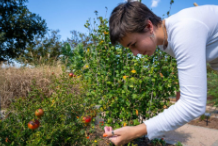Vegetable gardening doesn’t end just because it isn’t spring anymore! Fall is an excellent time to grow many vegetable crops. During this season the gardener can take advantage of cooler temperatures and more plentiful moisture.
For fall gardens, a guideline of when to plant common crops includes:
*Mid-July: Cabbage, broccoli and cauliflower can be started from seed at this time. These crops are generally transplanted in mid-August.
Plant potatoes if you can find them, or if you saved seed potatoes. Do not use freshly dug potatoes because they have a built-in dormancy that will prevent growth. Grocery store potatoes are often treated so that they don’t sprout.
*Late July. Plant seed beets, carrots and beans.
*Late July to early August. Plant seed spinach and long-season maturing lettuce.
*Second week of August. Transplant cabbage, broccoli and cauliflower to their final location.
*Mid- to late August. Plant seed radishes and leaf lettuce.
Vegetables such as broccoli, cauliflower, and Brussels sprouts are better adapted to fall gardening, since they produce best quality and flavor when they can mature during cooler weather. In Kansas the spring tends to heat up rather quickly. For many crops, insect and disease pests are not as much of a problem in fall plantings.
Late summer plantings often suffer from hot soil and a lack of water. Soils may form a hard crust over the seeds which can interfere with seed germination, particularly in heavy soils. Use a light mulch of vermiculite, compost, or potting soil over the seed row to prevent a crust from forming. Seeds of lettuce, peas, and spinach will not germinate well when the soil temperature is 85°F and above.
Shading the soil and using a light mulch over the seed row will help keep the temperature more favorable for germination. Planting the seeds slightly deeper than spring plantings may also be beneficial, since temperatures will be slightly cooler. Do not allow seedlings and young transplants to dry out excessively. Apply 1 inch of water in a single application each week to thoroughly moisten the soil. Young seedlings may need to be watered more often during the first week or two of growth. Young transplants may benefit from light shade for the first few days until their new roots become established.
After your plants have become established, the maintenance is just like any other garden. Make sure to control weeds and pests if necessary, and water when needed.





